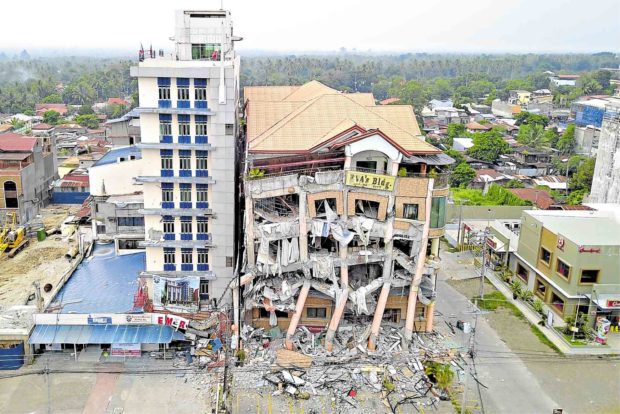
MISFORTUNE The heavily damaged Eva’s Hotel stands dangerously beside the Kidapawan Doctors’ Hospital (left) in Kidapawan City days after the Oct. 31 earthquake. The owners of the hotel say they are looking for a contractor who will charge a “reasonable price” for the demolition job. —ERWIN MASCARIÑAS
KIDAPAWAN CITY, Cotabato, Philippines — Nearly two weeks after the 6.5-magnitude earthquake that struck Mindanao on Oct. 31, the ruins of what used to be the six-story Eva’s Hotel stand dangerously over a busy junction here.
On Friday, Kidapawan Mayor Joseph Evangelista said he had issued a week’s notice to the owners to demolish the building, but the owners had asked for another week’s extension.
A portion of Claudio Street and Quezon Boulevard, where the hotel stands next to the Kidapawan Doctors’ Hospital, remains closed to traffic even after this capital city of Cotabato has started to recover from the devastation caused by the temblor that left 23 people dead and tens of thousands of others homeless in the worst-hit parts of the province and Davao del Sur.
Eva’s Hotel now looks like a five-story building, the upper floors having fallen on the first level. Its columned facade is crumpled like a paper bag, with the columns leaning precariously against the heavily damaged front wall.
So far, it is the only one condemned of the 20 or 23 buildings ordered closed after the earthquake, Evangelista said.
Artchie Viloria, the son of the building’s owners, told the Inquirer on Saturday that they had asked for another week’s extension because the P5 million sought by the demolition company that the city government had recommended was too much for them.
Viloria, the hotel’s manager, said the family was looking for a contractor who would charge a “reasonable price” for the job.
He said the city government had given them an ultimatum to demolish the structure or it would demolish the building itself and they would not be able to get the “recoverables” trapped inside the building.
“Imagine, in the hotel, there are still the air conditioners, the televisions in all of the 61 rooms and the orthopedic equipment there. How much do they cost?” he said. “The top floor of the building is where we live. We are still trying to recover all of our belongings there.”
Why the pressure?
He compared the actions taken by the Kidapawan city government to the way the local government of Davao handled things after the city’s NCCC shopping mall burned down in December 2017.
“If you remember the NCCC mall of Davao, which was burned because of faulty wiring, it was the Davao city government that shouldered the demolition cost of the structure,” Viloria said. “Why can’t the [Kidapawan] city government do that for us? After all, it was a natural calamity that struck us, and we’d been paying as much as P800,000 in local taxes yearly.”
Viloria said the hotel had never tried to avoid paying taxes nor had it sought city government services enjoyed by other investors.
“This would be the first time for us to avail [ourselves] of the services [of] the [city] government, so, why can’t [it] shoulder the demolition cost?” he asked.
“How come [the] Davao [city government] readily provided for the demolition [of the burned] NCCC mall, a classic example [of] where [the] government should step in and do its work,” Viloria said.
“Why are we being pressured by the mayor? Where does [the] calamity fund [go] in times of crisis?” he added.
Mayor Evangelista said four other structures that suffered heavy damage could also be condemned.
He said a team of structural engineers went around the city on Thursday to assess the integrity of structures and determine which of the 20 to 23 commercial buildings that had been closed could be retrofitted and allowed to resume operations.
Economic revival urgent
The mayor said the revival of the city’s economy was urgent.
“How many workers are out of jobs? They eat every day, [but] in another two weeks [if they can’t go back to work] they will become evacuees,” he said.
Evangelista said crisis management had to be done in just three weeks because after that the city would cease to be in the news, donors would stop coming, and the city would have to make do with its meager resources.
“My stockpile can only last seven days,” he said.